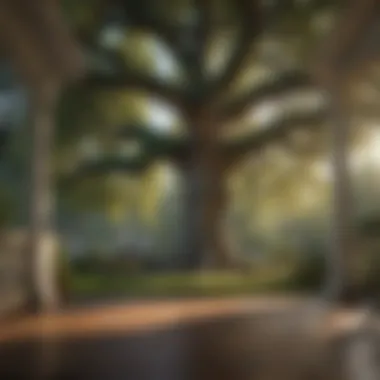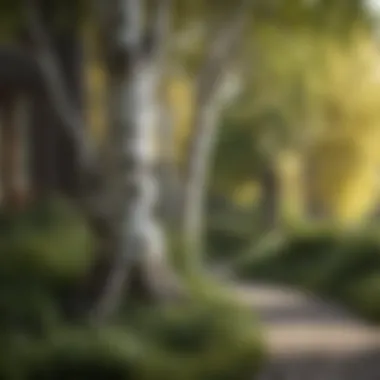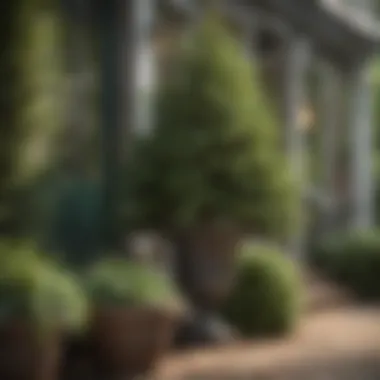How to Choose the Perfect Outdoor Tree for Your Porch


Intro
Choosing the right outdoor tree for your front porch is a significant aspect of home aesthetics. The tree you select can add beauty, shade, and even value to your property. It is essential to consider various factors like climate, maintenance, and design preferences when making such a decision. In this guide, we aim to assist homeowners and enthusiasts in navigating through the plethora of options available. We will explore diverse tree species suitable for different environments and discuss practical aspects that influence your selection.
Design Inspiration
Aesthetic Integration
The outdoor tree must harmonize with the existing architecture and style of your home. For instance, a traditional colonial-style home may benefit from the elegant lines of a weeping willow, while modern designs might call for the sleek appearance of a Japanese maple. Incorporating greenery effectively enhances visual appeal, guiding attention to your front porch.
Current Interior Design Trends
Interior and exterior design trends often influence one another. Currently, there is a shift toward biophilic design, which emphasizes a connection to nature. Trees like the olive tree are becoming popular for their charming appearance and minimal care requirements. They integrate well with modern design elements, providing tranquility and a sense of space.
Color Palettes and Their Effects
Color plays a crucial role in how trees complement your home. Different species bring varying shades throughout the year. Deciduous trees, such as the sugar maple, exhibit vibrant colors in autumn, while evergreens like the Colorado blue spruce maintain their rich hues all year long. When selecting a tree, consider how its color will interact with your home's palette.
Practical Considerations
Maintenance Requirements
Each tree has specific maintenance needs. Some trees require regular pruning and watering, whereas others, like the eastern red cedar, are low-maintenance and drought-tolerant. Homeowners should assess their availability for upkeep. Consider choosing varieties that align with your ability to care for them, ensuring sustainability in your landscaping.
Seasonal Changes and Impact
The visual appeal of trees can change dramatically with the seasons. Understanding these variations helps in selecting a tree that maintains interest year-round. Trees that flower in spring, such as the dogwood, can provide an impactful display. In contrast, trees with unique bark textures or shapes, like the birch, can offer aesthetic value even in winter.
Environmental Impact
Choosing the right outdoor tree also has implications for the environment. Trees absorb CO2, provide habitats, and add beauty to urban areas. Opting for native species enhances biodiversity, as these trees are adapted to local conditions. It’s prudent to investigate the ecological benefits of various options before settling on a choice.
"Selecting the right outdoor tree is not only about aesthetics but also about the long-term environmental benefits it brings."
Importance of Outdoor Trees in Exterior Design
Outdoor trees play a crucial role in enhancing the overall aesthetic value of any property. They are not merely decorative elements but also serve functional purposes that benefit homeowners and the environment. As you consider the selection of the ideal outdoor tree for your front porch, recognize how these choices impact your living space's visual appeal and utility.
One key benefit of incorporating trees in exterior design is the enhancement of visual cohesion. Well-chosen trees can complement architectural styles and create a harmonious connection between your home and its surroundings. This connection fosters an inviting atmosphere that draws attention in a positive manner. Additionally, trees add layers of color and texture throughout the seasons, offering a dynamic visual experience.
Trees also provide shade and cooling, which can greatly reduce energy costs during the hotter months. Strategically placed, they can cool the air around your porch, making the space more comfortable and usable during warm days. This practical benefit further elevates the value of selecting the right tree in exterior design.
Moreover, trees contribute to privacy. A well-placed tree can act as a natural barrier from the view of neighbors or passersby, enhancing the sense of seclusion on your porch. This boosts the comfort of outdoor living spaces, allowing residents to fully utilize their porches for relaxation or entertaining.
Overall, the selection of outdoor trees is more than just a choice of aesthetics; it reflects a broader understanding of design principles that consider both beauty and function. It is essential to engage with this important aspect carefully, ensuring that the trees selected enhance your exterior space in multiple dimensions.
Choosing the Right Tree Species
Selecting the appropriate tree species for your front porch is crucial for creating a harmonious exterior atmosphere. The tree you choose impacts not only the aesthetics but also the function of your space. Homeowners and design enthusiasts alike should consider several elements to make an informed decision that aligns with their preferences and practical needs.
Considerations for Climate


Climate plays a significant role in determining which tree species will thrive in your area. Each species has specific temperature tolerances and humidity requirements. It is essential to understand your hardiness zone, which informs you about the minimum temperatures for your location. For instance, a tree like the Eastern Redbud does well in temperate zones, while the Mediterranean Cypress prefers warmer climates.
Additionally, consider how rainfall patterns influence growth. Some trees, such as the Weeping Willow, require significant moisture, whereas others like the Olive Tree endure drought conditions well. Therefore, understanding local weather and environmental conditions is fundamental in selecting a tree that not only survives but flourishes.
Size and Growth Potential
It is essential to consider the size and growth potential of the tree you plan to plant. Trees vary dramatically in height, width, and growth rate, all of which directly affect their suitability for a porch setting. For example, smaller trees like the Japanese Maple typically reach heights of 10 to 15 feet, providing a modest but stunning addition to any entryway. On the contrary, large trees like the Oak can tower over 60 feet, which may not be appropriate for compact spaces.
Furthermore, think about the growth rate of the species. Some trees grow rapidly, such as the Silver Maple, allowing for quick visual impact, while others, like the Ponderosa Pine, take decades to reach maturity. This consideration is pivotal for homeowners who might wish to enjoy the benefits of their selections sooner rather than later.
Aesthetic Features
Aesthetic features of trees greatly influence the visual dynamics of a front porch. When selecting a tree, consider foliage color, texture, and seasonal changes. The vibrant reds of a Sugar Maple in the fall can create a striking contrast against the backdrop of a home, while the delicate flowers of a Flowering Dogwood in spring add a subtle charm.
Leaves also vary significantly in texture and shape, contributing to the overall look. For instance, the broad, lush leaves of a Magnolia tree can project an air of elegance that complements traditional architectural styles. In contrast, the narrow leaves of a Birch provide a more modern feel.
"Choosing the right tree demands a balance between personal preference and practical considerations to achieve the optimal result."
Popular Tree Options for Porches
Selecting the right tree for your porch can significantly affect the overall ambiance of your outdoor space. Trees provide numerous benefits, not only enhancing visual appeal but also contributing to ecological balance. Depending on your porch size and design preferences, the options may vary widely. Understanding the distinct categories of tree sizes available can help narrow your choices and allow for an informed decision.
Small Trees for Limited Spaces
Small trees are ideal for limited spaces, such as smaller porches or patios. These trees do not overpower the area, yet they still provide an attractive focal point. One popular option is the Japanese Maple. Its striking foliage, particularly in the fall, adds color and elegance without taking up too much space. Another good choice could be the Crape Myrtle. It offers beautiful blooms in summer, providing visual interest for several months.
Characteristics to consider include:
- Height: These trees generally range from 6 to 15 feet, making them suitable for low ceilings.
- Root System: A smaller root system means less disruption to surrounding structures.
- Seasonal Changes: Select varieties that offer year-round interest, not just seasonal beauty.
Medium-Sized Trees for Balance
Medium-sized trees provide a balance that can complement larger homes while still being manageable. The Flowering Dogwood is a noteworthy option. It provides lovely spring flowers and vibrant fall foliage. Another excellent candidate would be the Serviceberry tree, which produces small fruits and beautiful white flowers, great for attracting local wildlife.
When choosing medium-sized trees, consider these elements:
- Growth Rate: How fast will it reach maturity? Moderate growth rates can be ideal for front porches, allowing gradual integration as the tree matures.
- Aesthetics: Look for trees that will harmonize with the existing visual landscape, enhancing rather than overwhelming the space.
- Maintenance: Ensure that the tree does not demand excessive pruning or care once established.
Large Tree Choices for Impact
For those who prefer a dramatic impact, large trees can frame your porch beautifully. Options like the Magnolia tree offer stunning blooms and a sweet fragrance, turning the porch into a tranquil retreat. Similarly, the American Elm is an excellent choice for its broad canopy and sweeping branches, providing ample shade during summer months.
Key factors when selecting large trees include:
- Canopy Size: Ensure that the canopy does not block important views or interfere with the porch area.
- Root Impact: Large trees can create substantial root systems, so selecting a variety suited to the stability of your foundation is crucial.
- Longevity and Care: Think long-term. Many large trees can last for decades, so select one that will create legacy and appeal over the years.
"The right tree can transform a simple front porch into an inviting outdoor living area, enhancing both aesthetics and environment."
Selecting the ideal tree for your front porch involves understanding each category of available options. By taking into account the space you have, along with personal preference in aesthetics, you can create a beautiful and harmonious outdoor area.
Maintenance Considerations


Selecting an outdoor tree for your front porch includes considering how to maintain it. Maintenance is vital because it ensures the tree remains healthy and visually appealing. Proper care helps extend the tree's lifespan and enhances the overall aesthetics of your outdoor space. A well-maintained tree can be a highlight of your porch, while neglect can lead to a range of problems that can detract from your home’s exterior design.
Watering Requirements
Watering needs vary depending on the type of tree selected. Establishing a consistent watering routine is essential, especially during the early stages after planting. Newly planted trees typically require more frequent watering to promote root establishment. An effective guideline is to water deeply once a week during dry periods. Specific species may have particular preferences; for example, Japanese Maple requires well-drained soil but enjoys regular watering to prevent wilting. Be mindful of the local climate and adjust the watering frequency accordingly. Utilizing mulch can help retain moisture, reduce evaporation, and maintain soil temperature, which benefits the tree.
"The right watering practices significantly affect tree health, so observe your tree's condition regularly."
Pruning and Shaping Needs
Pruning is essential for maintaining both health and aesthetics. It is important to remove dead or diseased branches to prevent further issues. The ideal time for pruning depends on the species. For most trees, late winter or early spring is appropriate, while others may require summer pruning. Shaping the tree not only enhances its appearance but also aids in overall growth. It helps in developing a strong structure, which can support heavier branches as the tree matures. However, avoid over-pruning, as this can stress the tree and negatively impact its growth and shape.
Pest and Disease Management
Regular monitoring for pests and diseases should be a part of your maintenance routine. Trees can be susceptible to various pests such as aphids, scales, and borers. Notice any unusual discoloration or wilting leaves, as these can signal problems. Implementing integrated pest management strategies can effectively manage infestations without relying solely on chemical solutions. This includes encouraging beneficial insects, such as ladybugs, which feed on harmful pests. Additionally, ensuring good air circulation and proper watering practices helps prevent fungal diseases.
Seasonal Changes and Their Effects
Seasonal changes play a crucial role in how outdoor trees interact with your front porch environment. Homeowners must be aware of the influence each season has on tree growth, aesthetics, and maintenance needs. Understanding these factors can guide you in making informed decisions about which trees to plant and how to care for them throughout the year. This section will focus on the distinct considerations for fall and winter, as well as spring and summer.
Fall and Winter Considerations
As the days grow shorter and temperatures drop, trees begin the process of dormancy. This natural cycle is essential for their overall health and longevity. In the fall, many trees will shed their leaves, creating a different kind of beauty. The brilliant colors of autumn can be quite striking, especially in species like Liquidambar styraciflua, commonly known as sweetgum.
However, this season also brings challenges. With the leaves falling, homeowners may need to consider additional cleanup. Regular maintenance, such as raking leaves and ensuring that branches are not overly heavy with snow, can protect both the tree and the porch area.
In winter, exposed trees can create a serene landscape. However, it is essential to monitor the trees for frost damage or potential breakage under heavy snow. Some evergreens, like Thuja occidentalis, or eastern arborvitae, offer year-round greenery, contributing to the visual appeal even in the cold months. Choosing appropriate trees for winter aesthetics enhances the front porch's charm during the less colorful months.
Spring and Summer Growth
Spring marks the awakening of outdoor trees. As temperatures rise, trees enter a phase of significant growth, producing leaves, buds, and flowers. Species like Prunus serrulata, or cherry trees, are particularly celebrated for their vibrant blossoms, which can transform a front porch through vibrant displays. This growth stage is vital for photosynthesis, allowing the tree to build energy for future seasons.
However, this is a period requiring careful attention. Regular watering is essential, especially in the early summer, when heat can stress the trees. Fertilization is often beneficial to support new growth and ensure vibrant foliage. It is also a good time to assess the health of the trees, looking for any signs of pests or diseases.
Managing space in the area around your porch becomes crucial as trees grow. Occasionally, pruning may be necessary to shape the trees and encourage healthy growth patterns. Leaving sufficient space allows for air circulation and sunlight, which are both important for the health of the tree and any potential plantings nearby.
"Understanding seasonal growth patterns can help homeowners maximize the visual impact of trees and ensure that they thrive year-round."
By closely observing seasonal changes, homeowners can enhance the beauty of their front porches while ensuring that their chosen trees thrive through proactive care.
Environmental and Ecological Implications
The choice of an outdoor tree holds significant consequences not just for individual gardens but for the broader ecosystem. Trees contribute to ecological balance and can enhance the local environment in various ways. Understanding these implications allows homeowners to select trees that positively affect their surroundings. The benefits can be broad-ranging, encouraging mindful selections that preserve local biodiversity and promote sustainable practices.
Impact on Local Wildlife
Trees provide essential habitats for various species of wildlife. Birds and insects often rely on trees for their nesting sites, while mammals may use them for shelter and food. Incorporating tree species that bear fruit or nuts can attract local fauna, enriching your garden's ecosystem. For example, planting a dogwood tree not only offers stunning spring blooms but also supplies berries that birds consume.
Moreover, trees help to foster biodiversity. When selecting trees for your porch, consider native species as they typically require less care and resources. Native trees often support the local wildlife better than non-native varieties, as they evolved alongside local species. This interconnectedness is crucial; it supports pollinators and keeps pests in check without the need for chemical interventions.
"Selecting trees that support local wildlife can lead to a thriving garden ecosystem, benefiting both plants and animals."


Sustainability Considerations
When considering tree options for your porch, sustainability should be a significant focus. Selecting trees that are well-suited to your climate reduces the need for excessive water and care. Native species generally thrive in local conditions, which minimizes maintenance efforts while maximizing growth potential. Thus, opting for trees that naturally flourish in your area can enhance sustainability.
Additionally, trees play a vital role in combating climate change. They capture carbon dioxide from the atmosphere, contributing to cleaner air. By integrating trees into your landscape, you are participating in carbon sequestration efforts that can positively impact global warming.
Homeowners should also think about the longevity and overall health of the trees they choose. Investing in well-researched, robust species can lead to a healthy forest ecosystem that lasts for generations. Sustainability does not stop at the planting; ongoing care, minimal environmental disruption, and choosing disease-resistant varieties further extend the ecological benefits. Managing your tree’s growth responsibly is beneficial for both your home and the local environment.
Integration with Other Landscape Features
Selecting an outdoor tree for your front porch is not just about the tree itself. It is essential to consider how this tree integrates with other landscape features. A well-planned integration can enhance the overall aesthetic and function of your outdoor space, creating a harmonious environment.
Benefits of Tree Integration
Proper integration can provide various benefits that influence how the porch and surrounding landscape are perceived. This includes:
- Visual Cohesion: When the tree complements other plants, it creates a unified look that pleases the eye.
- Functional Space: Trees can offer shade for your porch, making it a more comfortable area to enjoy.
- Wildlife Attraction: Integrating a tree can improve local wildlife access, supporting birds and beneficial insects.
Key Considerations
Integrating trees effectively requires careful consideration of many factors. Some of these include:
- Plant Height and Canopy: Ensure that the tree does not overshadow the porch or its adjacent areas.
- Growth Habit: Opt for trees that will not interfere with existing structures or utilities as they mature.
- Seasonal Changes: Select species whose seasonal transformations will add visual interest over time.
Complementary Plantings
Adding complementary plantings around your selected tree can significantly enhance the aesthetics and function of your front porch. These plantings should harmonize with the tree in terms of color, size, and growth patterns.
Choosing the Right Plants
- Shrubs: Shrubs like hydrangeas or azaleas can create a soft border around the tree, offering year-round interest and blooms.
- Ground Covers: Incorporate ground covers such as creeping thyme or moss to fill in bare spots, preventing weeds while beautifying the space.
- Flowering Plants: Seasonal flower beds can bring pops of color that enhance both the tree and the porch.
Spacing and Arrangement
It’s essential to plan the spacing carefully:
- Plant in clusters for a more natural look.
- Ensure there is enough room for each plant’s growth needs without overcrowding.
Porch and Tree Synergy
The relationship between your porch and the selected tree can create a distinct ambiance. Understanding this synergy is vital for maximizing the porch's usability and appeal.
Creating a Cohesive Environment
When you select a tree, think about the materials and colors of your porch.
- Color Coordination: A tree with vibrant flowers can complement a neutral-toned porch, creating a pleasant contrast.
- Material Harmony: If your porch features wooden elements, incorporating trees with similar textures can enhance the natural feel.
Functional Aspects of This Synergy
The tree can serve functional purposes as well:
- Shade Provider: Choose a tree that provides shade during hot months, making the porch more enjoyable.
- Windbreak: Trees can act as a windbreak, protecting you from harsh weather while you enjoy your outdoor space.
Integrating a tree with other outdoor elements not only beautifies your front yard but also supports various functions that enhance your overall experience. Take time to evaluate the space, consider the relationship between plants, and think about how these elements will work together. These practices can lead to a flourishing and inviting atmosphere around your porch.
Culmination
The conclusion of this article serves as an essential synthesis of the vital themes discussed regarding the selection of outdoor trees for front porches. Selecting the right tree is not merely an aesthetic choice but intertwines with usability, ecological impact, and personal preferences. This critical decision can enhance both the visual attractiveness of your home and provide practical benefits such as shade and air quality improvement.
Recap of Key Points
To summarize the main points covered:
- Importance of Outdoors Trees: They increase visual appeal and create a welcoming atmosphere. The right tree can elevate your porch’s design significantly.
- Choosing the Right Species: Always consider climate conditions, size potential, and unique aesthetic features of the tree species. Each element plays a pivotal role in ensuring your tree thrives.
- Popular Tree Options: Knowing the right tree sizes can help with limitations in space. This includes small trees for limited areas, medium-sized trees for balance, and large options for visual impact.
- Maintenance Requirements: Regular maintenance is crucial. This includes understanding watering needs, pruning, and managing potential pest issues to keep your trees healthy.
- Seasonal Considerations: A tree’s appearance and growth can change with the seasons, influencing its impact throughout the year.
- Environmental Implications: Planting trees can positively affect local wildlife and contribute to ecological sustainability.
- Integration with Landscape Features: Designing a cohesive outdoor space that includes complimentary plantings and purposeful porch integration can enhance your overall exterior.
Final Thoughts on Outdoor Trees
In selecting an outdoor tree, it is essential to align the choice with the home’s design, personal taste, and environmental factors. A thoughtfully chosen tree not only beautifies your porch but also serves functional roles and promotes sustainability. When considering outdoor trees, keeping future growth, maintenance, and ecological impacts in mind leads to informed decisions that reflect both style and substance. Take pride in your choices, as they will resonate for years to come, offering enjoyment and enhancing the beauty of your home.















